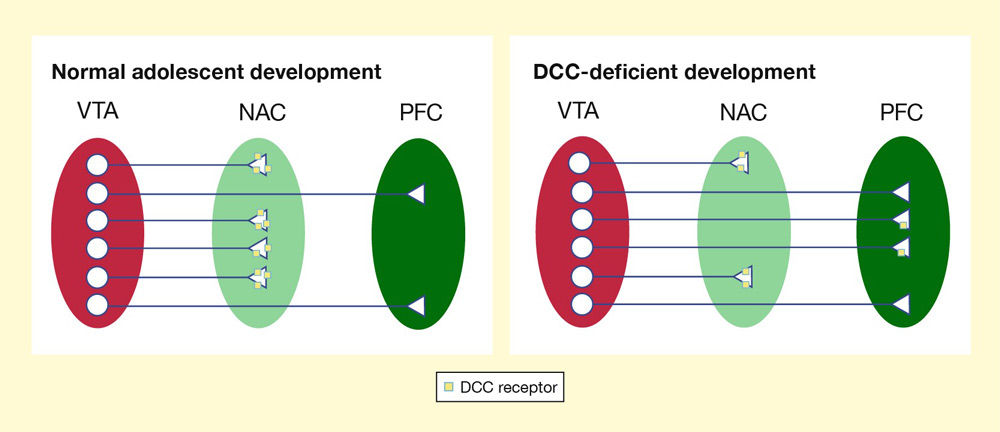Prefrontal cortex gains new dopamine axons
Developmental changes in prefrontal cortex underlie the maturing of cognitive functioning and emotional control that occurs in adolescence. These changes include the expansion and refinement of existing dopamine circuitry in the region, and—a new study shows—the arrival of new dopamine axons from neurons in the ventral tegmental area (VTA).
 In wild-type mice, dopamine axons expressed high levels of DCC receptors and most formed synapses in the NAC. In genetically engineered mice with reduced DCC, more dopamine axons passed through the NAC and formed synapses in the PFC. Source: Adapted with permission from Dr. Cecilia Flores.
In wild-type mice, dopamine axons expressed high levels of DCC receptors and most formed synapses in the NAC. In genetically engineered mice with reduced DCC, more dopamine axons passed through the NAC and formed synapses in the PFC. Source: Adapted with permission from Dr. Cecilia Flores.Supported by the National Institute on Drug Abuse, this study demonstrated that the new axons arrive via a pathway that originates in the VTA and passes through the part of the forebrain called the nucleus accumbens (NAC). The researchers labeled these axons in preadolescent mice. When the animals reached adulthood, some of the labeled axons had lengthened and extended to the prefrontal cortex.
However, only a small portion of these migrating axons pushed on into the prefrontal cortex during adolescence. The researchers established that a receptor called DCC acts to keep most of them from continuing further. The receptor, located in dopamine axon tips, determines where the axons form intermediate and terminal connections.
The researchers learned that when they reduced the DCC via genetic manipulation, the animals exhibited greatly increased dopamine axon extension into the prefrontal cortex. These DCC-deficient mice also performed better than wild-type mice on behavioral tests of cognitive flexibility and impulse control. These findings shed light on how genetic and environmental factors may interact in adolescence to influence the structure and function of the prefrontal cortex.
Study:
- Reynolds, L.M. et al. DCC receptors drive prefrontal cortex maturation by determining dopamine axon targeting in adolescence. Biological Psychiatry.
